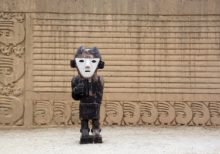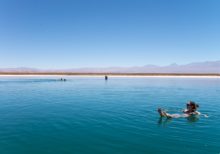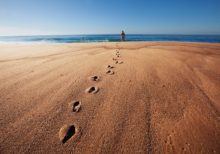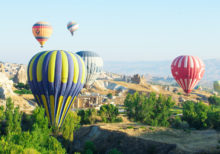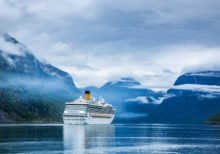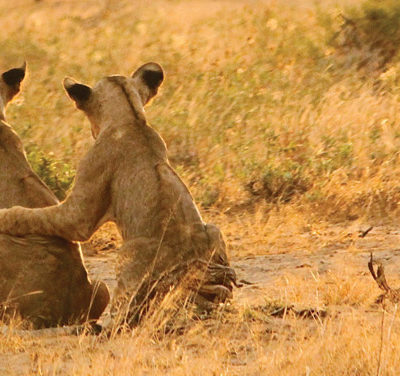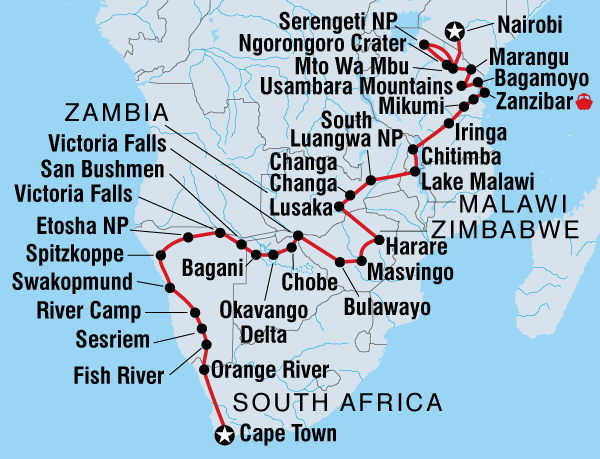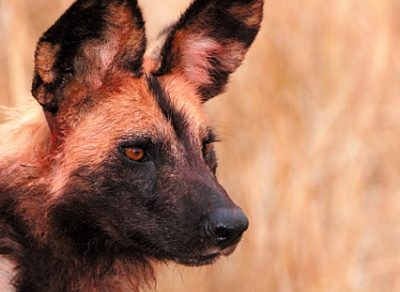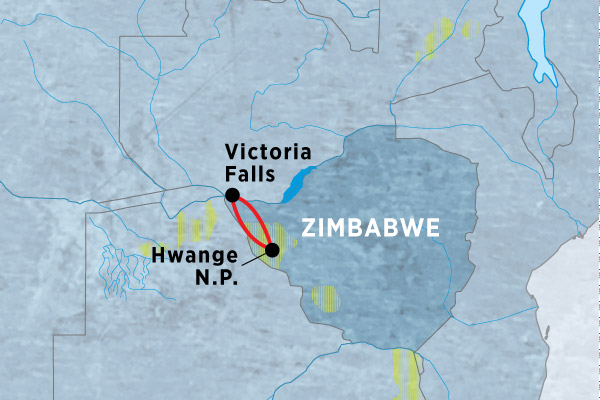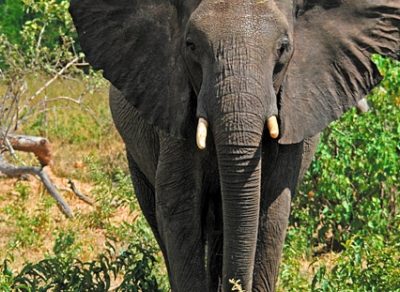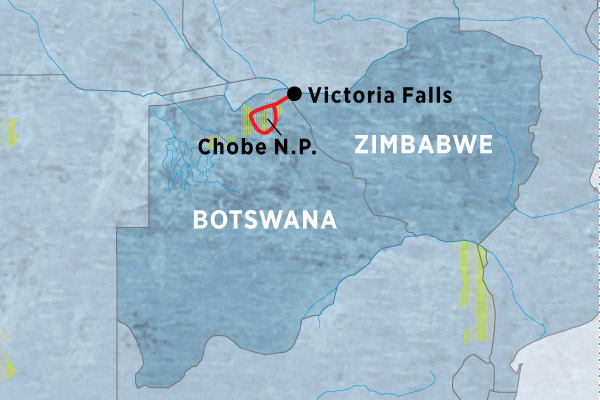| Starts | Victoria Falls, Zimbabwe, Zimbabwe |
|---|---|
| Ends | Cape Town, South Africa, South Africa |
| Region | Africa |
| Duration | 22 days |
| Tour Operator | Peregrine |
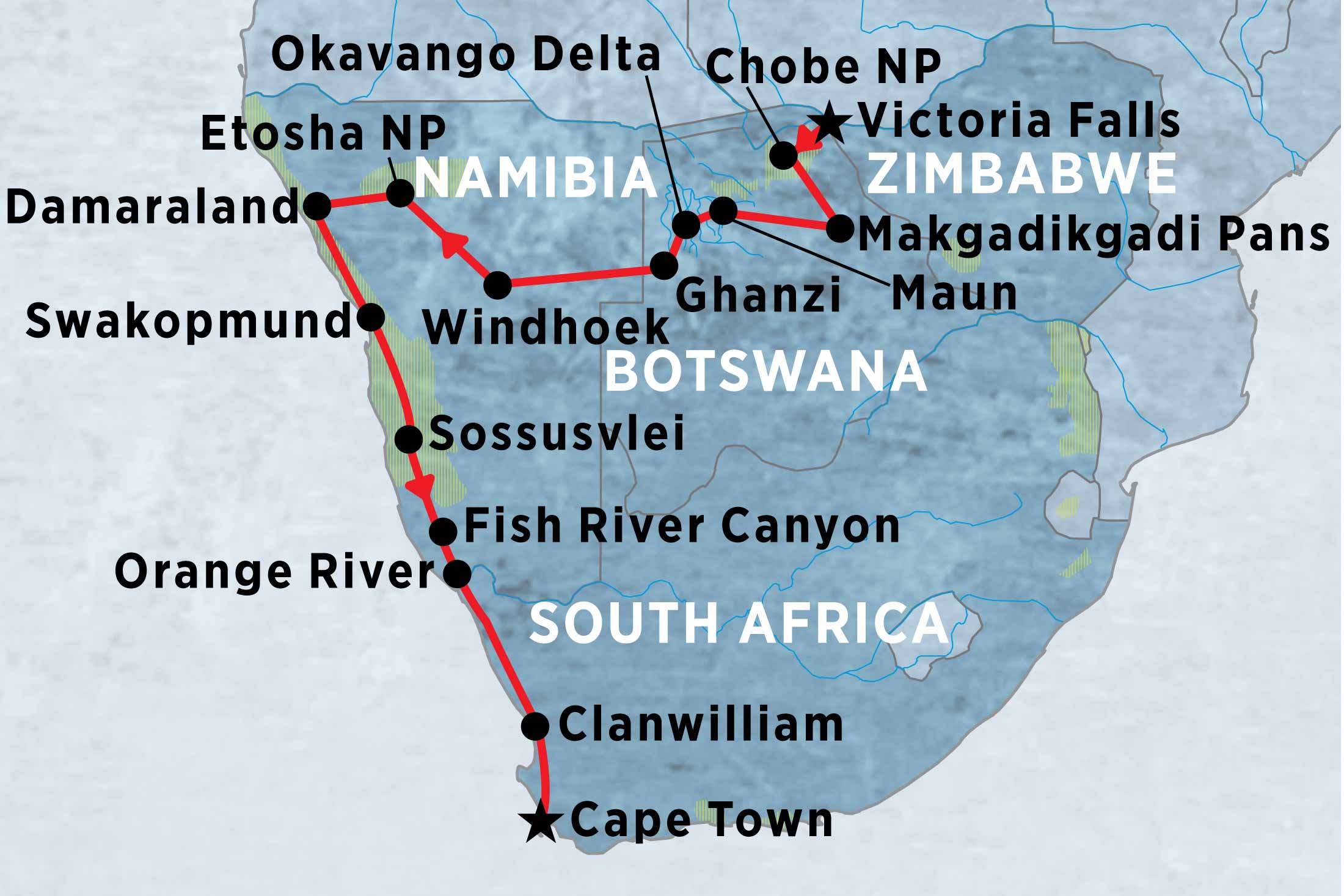
Itinerary
Day 1 - Starting: Victoria Falls & Finishing: Victoria Falls
This adventure begins with an included airport arrival transfer to your hotel (please provide your flight details at the time of booking, or at a minimum 15 days prior to travel, to organise this). You will be met by a Peregrine representative and transferred to your lodge (approximately 45 minutes). The afternoon will be free to spend at your leisure. Take a stroll around town and book with local tour operators any optional activities that you’d like to do while you’re here. Then, what better way to kick off your African adventure than with a superb feast. Tonight you'll enjoy an incredible dinner at the Boma Restaurant. A Boma was historically an enclosure constructed from closely-knit sticks used to keep in animals or fortify a village. The Boma creates an atmospheric setting for a dinner, lit by torches and surrounded by bush. The mouth-watering main course is a buffet of local meats, which may include warthog, buffalo, crocodile, impala and more. Throughout the meal you'll be entertained with local song and dance, with everyone given an African drum and encouraged to join the party. Notes: If you do not wish to join in with the drumming you can choose an earlier session for dinner. There will also be no guide with you for dinner tonight. The Boma Restaurant is located on the same grounds as the Victoria Falls Safari Lodge, and you can either take the free shuttle bus that will drop you off at the front of the restaurant, or walk over. The walk will take you less than 10 minutes.
Day 2 - Starting: Victoria Falls & Finishing: Victoria Falls
This morning you will visit the magnificent Victoria Falls, named by Dr David Livingstone in honour of his English queen. One of the world's true natural wonders, Victoria Falls form the largest sheet of falling water in the world when in full flow. The falls are also commonly referred to by their Kololo name, Mosi-oa-Tunya, or 'the Smoke That Thunders' and you’ll see and hear why on a morning tour. Once inside the park, your guide will take you through the falls area, stopping at different vantage points along the way to explain the history of the falls and their surrounds: hundreds of miles away in northern Zambia a little spring wanders along the earth, eventually ending in over 1 million gallons of water torrenting down a 328-foot high drop a mile wide. After your tour, you will return to your lodge, where the rest of the day will be at leisure to enjoy any optional activities you may have booked. Your leader will take you to a local activity centre where a range of activities will be on offer. We have not risk assessed all activities and only those listed in our trip notes are recommended. If you are unsure please check with your leader. Please note that it is against company policy for leaders to facilitate the booking of any activities that have not been risk assessed or do not adhere to our company’s Responsible Travel policy and ethos. This includes organising transport to and from these activities in our vehicles. On the water you can white water raft on the river below the falls with some of the best rapids in the world or take a leisurely cruise at sunset. For something a little more hair-raising there are rope-based activities around the gorge, or a jaw-dropping helicopter flight over the falls and the Zambezi Gorges.
Day 3 - Starting: Chobe National Park & Finishing: Chobe National Park
Follow the Zambezi River to Botswana and make your way to Chobe National Park (approximately 2–3 hours, not including border formalities). You will arrive at your lodge at around midday, which is located on the bank of the Chobe River just outside of the National Park. This is where you'll spend the next two nights. Here you can relax by the pool or take an optional afternoon game drive in Chobe National Park. This can be arranged locally with your leader. If you take a game drive you’ll almost certainly see elephants drinking at the waters' edge, and keep your eyes open for the park’s large herds of buffalo too. Accommodation at Chobe Safari Lodge is usually in rondavels – comfortable individual circular thatched units with private facilities and balconies. The lodge bar is a great place to enjoy a drink at the end of the day, and dinner is often served outside with a smorgasbord of options. The lodge pool is also the perfect place to wash off the heat off the day or safari dust.
Day 4 - Starting: Chobe National Park & Finishing: Chobe National Park
Today is a full day of wildlife exploration. You’ll begin with a morning game drive to see the animals at their most active, followed by some time back at the lodge for relaxation during the hottest part of the day. Then, in the late afternoon, you’ll take a boat trip out on the Chobe River. Chobe National Park is archetypal big-game county, where huge herds of buffalo and elephants are matched by the size of the lion prides. An estimated 70,000 Kalahari elephants roam the park and are the largest known subspecies of elephant in the world by size. You may also see zebra, impala, wildebeest and giraffe. The bird life on the river can be truly spectacular with sightings of saddle-billed storks, malachite kingfishers, fish eagles, goliath herons and beautiful bee-eaters. Elephants will often congregate to drink and play in the river, and there are good hippopotamus numbers too. You might even spot a crocodile on the riverbanks – although they are surprisingly shy. Extra layers of clothing are essential here, especially for cold early mornings in the open vehicle.
Day 5 - Starting: Makgadikgadi Pans & Finishing: Makgadikgadi Pans
Heading south, you will continue your journey (approximately 6 hours) to the Makgadikgadi Pans for an afternoon excursion. Witness the immensity of this sprawling salt flat, one of the largest in the world. Later you will head to your lodgings, the marvellous Nata Lodge, located just on the edge of the pans. Accommodation here is in air-conditioned thatched chalets built on stilts, with a charming, rustic African quality. The chalets have ensuite bathrooms with an indoor freestanding bath and an outdoor shower. Spend some time unwinding by the pool or relaxing in the lounge area while you take in your surroundings and reflect on the day's adventure.
Day 6 - Starting: Maun & Finishing: Maun
After breakfast this morning, it's time to head to Maun, the gateway of the Okavango Delta (approximately 5–6 hours). For those interested, there is the opportunity to fly over the delta in a small plane for a bird's-eye view. This is a great way to appreciate the vast scale of this waterscape. The delta has the shape of a hand – a palm permanently filled with water, and the fingers flooded seasonally, creating a blue-green wilderness of fresh water. This area is an incredible source of life in a country that is 80 per cent arid. Your leader can give you more information on the flight and how to reserve a place. Otherwise, the afternoon yours to spend as you please.
Day 7 - Starting: Okavango Delta & Finishing: Okavango Delta
Venture to the Okavango Delta (approximately 6 hours) and board your speedboat. This will take you to your home for the next two nights, a houseboat in the middle of the delta. You will need to pack a small bag or backpack for this trip, as there won't be room for everyone's full luggage. The houseboat has twin-share cabins with bedding, towels and mosquito nets provided (however, no single supplement is available on these nights). There is also a dining area on the deck, tea- and coffee-making facilities and a small collection of books and board games. As evening falls, head to the deck, where your captain will serve dinner. Enjoy an ice-cold sundowner and take in the ambience of the Hippos moving about at the water's edge. Notes: Cabins are very small and basic, but it is of course unlikely that you will be spending much time in them. On occasion, the houseboat will be unavailable due to regular servicing and maintenance requirements; if this occurs, alternative arrangements on land will be made.
Day 8 - Starting: Okavango Delta & Finishing: Okavango Delta
This morning after breakfast you will take a speedboat and 4WD to a nearby poling station. From here you will experience the myriad waterways in a traditional dugout canoe (mokoro) with a local guide. Your guide will also take you on a nature walk around one of the many Islands in the Delta. After a picnic lunch, return to the houseboat for some relaxation time. You might like to read a book or do some fishing. In the evening, enjoy a drink, pull up a chair and witness the often breathtaking sunset before your captain serves up dinner once again on the deck.
Day 9 - Starting: Ghanzi – Central Kalahari & Finishing: Ghanzi – Central Kalahari
Travel on to Ghanzi, the 'Capital of the Kalahari' (approximately 7 hours). Your accommodation tonight is at a community project in Ghanzi and is a little more basic than what you will encounter throughout your journey. However, the concept and experience of Dqae Qare San Lodge is well worth it. It is run and owned by the local San Bushmen and supports the San D'Kar community through employment. There is an impressive concentration of bird life here, and you may wish to go for a walk before dinner to stretch your legs after today's long stint in the vehicle. A three-course meal, prepared by the local women, will be served in the communal lounge and dining area. There is also an 'honesty' bar with wine, beer and soft drinks available to buy. Later this evening you will be treated to an enlightening cultural experience. As you sit around the campfire, the Bushmen will share their extraordinary knowledge of the Kalahari and culture through stories and traditional dancing.
Day 10 - Starting: Windhoek & Finishing: Windhoek
Cross the border into Namibia and head to Windhoek (approximately 6 hours). On arrival, take a stroll around the town and visit some of its museums or perhaps take a township tour. Take in the German architecture evident in a number of buildings. The finest are the Tintenpalast (Ink Palace), the Christuskirche (church), the gymnasium and the Genossenschaftshaus. As this is a combination trip, some of your fellow travellers may be leaving you this evening. There will be another group meeting at 6pm and it will be a great opportunity to meet any new travellers who will accompany you through Namibia.
Day 11 - Starting: Etosha National Park & Finishing: Etosha National Park
Travel to Etosha National Park (approximately 7–8 hours). Time permitting, you might embark on a short afternoon game drive when you arrive this afternoon. This is one of the world's premier game-viewing destinations and the third largest wildlife sanctuary in the world. Spotting animals in the park is relatively easy due to the man-made waterholes and the large, sparsely vegetated pans. The bushland surrounding the pans is difficult to see through, but there are enough clearings, pans and waterholes to allow for sightings. Namibia has protected its game reserves against poaching, so there are large herds of elephants, antelope and other herbivores.
Day 12 - Starting: Etosha National Park & Finishing: Etosha National Park
Enjoy a full day of game viewing in the truck. The Etosha Pan (the word 'pan' meaning either a wet or dry waterhole) that forms about a third of the park is a vast shallow depression 139 kilometres long and 50 kilometres wide, and is all that remains of a once great inland sea. It is essentially dry for much of the year, resulting in a shimmering sea of white salt. However, a number of permanent springs located along its southern shores provide sustenance for the many wild animals that are attracted to the springs. Keep a close eye on the landscape for black rhino, Hartmann's mountain zebra, black-faced impala, roan antelope and the tiny Damara dik-dik. The park is also home to some 340 bird species. Afterwards you will return to the lodge, where you can go for a refreshing swim in the pool. Reflect on the day's adventures with your fellow travellers over dinner.
Day 13 - Starting: Damaraland & Finishing: Damaraland
Venture off the beaten track as you head into the heart of Damaraland (approximately 7 hours). You should arrive at your lodge early this evening. Accommodation for the next two nights is situated on the banks of the Hoanib River in the Khowarib Gorge and is a feature stay on this itinerary. Ensuite tented chalets have viewing platforms over the riverbank with outdoor bathrooms. Home to Namibia's highest peak, ancient rock paintings and petrified forests, the harshly beautiful and sparsely populated Damaraland region is a land of extraordinary contrasts. On the way to your lodge, you will spend the afternoon visiting the surrounding sights such as Twyfelfontein Heritage Site and the Petrified Forest. Depending on the time of year, you might be lucky enough to see the desert elephants that roam the area. Many of the roads we travel on today will be untarred and often corrogated. They are some of the worst on this itinerary so be prepared from some extra bumps. We will be accompanied by local guides at both the Petrified forest and the Twyfelfontein sites. The guided walks take between 30-60mins and although not difficult there are some steep rocks and hills at the Twyfelfontein site. It can get hot at this time of day so be sure to have a hat, sunscreen and a bottle of water with you.
Day 14 - Starting: Damaraland & Finishing: Damaraland
Today is a free day for you to explore the region and perhaps look at some of the optional activities in the area. There are a number of optional activities that the lodge staff can organise for you including guided nature walks, a village visit to meet the local Himba people, or a 4x4 safari to track Elephants. Notes: Daytime temperatures in this area often peak around 30°C, so it's best to see sights as early as possible before the heat becomes too intense. This way you can spend the remainder of your day back at the camp, relaxing by the pool or in the shade.
Day 15 - Starting: Swakopmund & Finishing: Swakopmund
Travel on through the Namib Desert today (approximately 8-9 hours) to reach the Atlantic Ocean coastline. Take in the beautiful, diverse and colourful landscapes that stream past along the way; mountains, sand dunes, ocean waves and, shipwrecks. Your destination is the beachside town of Swakopmund on the Skeleton Coast. Upon arrival at Swakopmund, you will check into your hotel and have free time to enjoy this interesting township of German-Namibian atmosphere. The accommodation is within walking distance of the town, and you can enjoy a walk on the beach, or visit the open-air markets or local museum. Your leader will take you to a local activity centre where a range of activities will be on offer. We have not risk assessed all activities and only those listed in our trip notes are recommended. If you are unsure please check with your leader. Please note that it is against company policy for leaders to facilitate the booking of any activities that have not been risk assessed or do not adhere to our company’s Responsible Travel policy and ethos. This includes organising transport to and from these activities in our vehicles.
Day 16 - Starting: Swakopmund & Finishing: Swakopmund
With free time today, you may wish to take an optional trip north to Cape Cross, a breeding site for Cape fur seals. There can be in excess of 100,000 seals there at any given time, making for quite the spectacle. Quite a smell too, if the wind happens to change direction. Wander the coastline and attempt to document these beautiful creatures in a photo or two, and visit the large cross that sits nearby, left there by Diego Cao (the first European to arrive on Namibian soil in 1485). There are also a number of optional activities available here (at extra cost) for those who are interested.
Day 17 - Starting: Sossusvlei & Finishing: Sossusvlei
Depart your coastal retreat in Swakopmund and head south today towards Sesriem. (approximately 6 hours). Walvis Bay is the hibernation area for thousands of migratory birds, most notably Flamingos. If in season you may take quick detour to see these elegant birds. Continue on past moon valley; an eerie rocky granite valley, and the Tropic of Capricorn. Stop by the small settlement of Solitaire before arriving at your lodge. Scattered with abandoned trucks, cars, petrol pumps and cacti, It's the only place between Walvis Bay and Sossusvlei to feature a petrol station, post office, general dealer, and bakery! The local Apple Pie has earned itself quite a reputation too.
Day 18 - Starting: Sossusvlei / Sesriem & Finishing: Sossusvlei / Sesriem
Make an early-morning visit to Sossusvlei, which lies at the end of an ancient riverbed. This is a great opportunity for unsurpassed views of the surrounding area. Remarkably, once every ten years the dry cracked earth of the Sossusvlei salt pan transforms into a luscious flowing river which attracts countless animals. Climbing to the top of Dune 45 will reward you with spectacular vistas of the surreal desert landscape. After breakfast head to Dead Vlei. A clay pan well known for the iconic postcard like images taken here by many. The pan is surrounded by some of the highest dunes in the world, "Big Daddy" or "Crazy Dune" average about 350m. If you'd like to avoid a long walk in the sun you can opt to pay for a 4x4 transfer from the 2x2 car park out to the Dead Vlei entrance point. This will cost approximately 100NAD per person. In the afternoon you will visit Sesriem Gorge, tranquil natural corridor you can walk through and explore. The canyon was caused by a continental shift two to four million years ago in the 18-million year old rocks. The people who lived in the area used to pull buckets of water up from the depths with six knotted belts. Therefore, the canyon was named after the Afrikaans word “Sesriem” meaning “six belts”. Head back to the lodge for the evening.
Day 19 - Starting: Fish River Canyon & Finishing: Fish River Canyon
Depart Sossusvlei early this morning and head to Fish River Canyon (approximately 8-9 hours ). If we have time we will check into our lodge quickly before heading to the Canyon for sunset. At 500 metres deep and over 160 km long, Fish River Canyon is one of the largest canyons in the world, ranking close in size to Peru's Colca Canyon and the Grand Canyon in the USA. You will stop at various lookouts that reveal fantastic views. Keep an eye out for some of the birds that inhabit this area, including plovers, wagtails, hammerkops and herons. If you're lucky you might even catch a glimpse of a baboon or antelope at dusk. In the afternoon, the magnificence of the canyon is amplified as the setting sun reflects off walls and changes their colour. There are remarkable photographic opportunities here, and you'll have plenty of time to take in the sunset glows before heading to your lodge. It's easier to see why the Canyon Lodge is a feature stay on this trip. The natural stone chalets and perfectly landscaped gardens really make it feel like an oasis in the middle of nowhere.
Day 20 - Starting: Orange River & Finishing: Orange River
Farewell Fish River Canyon and head on to Orange River, just a short 2.5-3hr drive away. You should reach your destination on the banks of the river by lunchtime. The Orange River is the longest stream in South Africa, running from high up in the Drakensberg mountain range and into the Atlantic Ocean. This stream is significant for its role in transporting diamonds, which in turn leaves the deposits that are found along the Namibian coastline. Set off this afternoon on a 10km canoe journey down the Orange River. The canoe trip will be done in 2 man canoes with a local guide. It is a slow paced trip covering approximately 10km and we should be travelling down stream for most or all of the trip.
Day 21 - Starting: Clanwilliam & Finishing: Clanwilliam
Leaving Namibia behind, you will cross the border and head into South Africa (approximately 8 hours), passing through landscapes that feel unchanged over thousands of years, and then scenery expansive wild flower carpets and Rooibos tea farms. Arrive at your guesthouse in the late afternoon or early evening, depending on how much time it takes for border crossing formalities and photo stops along the way. Tonight will be spent in the quaint town of Clanwilliam.
Day 22 - Starting: Lambert's Bay – Cape Town & Finishing: Lambert's Bay – Cape Town
Travel to Cape Gannet Island today in Lambert's bay ( approximately 1hr ). At the right time of the year, you might be lucky enough to view the spectacular flocks of gannet, which make use of the spot for breeding in August and September. The colony at Lambert's Bay is the most accessible of the six gannet colonies in South Africa and Namibia. It's amazing to watch these creatures in their tightly packed community, as they wheel, land and settle into their designated positions. Enjoy a delicious seafood lunch today at a local open-air restaurant which boasts world-class ocean views. Continue on to Cape Town ( approximately 4-5hrs ) where this trip finishes on arrival. Notes: If you're flying out of Cape Town today, it's best you don't book a flight that departs before 10 pm. You can choose to stay on in Cape Town if you wish, just ask about additional accommodation or the Cape Town Independent Experience when you book the trip. If you have extra time, Cape Town, with its internationally recognised beaches, is a great place to kick back and relax. If you'd rather get active, hop inside the revolving cable car and set off on one of hundreds of hiking trails that criss cross Table Mountain to its summit, stopping off the admire the views of Camps Bay below. If you've got energy left perhaps strap on a harness and abseil down. Other attractions worth a visit include the Kirstenbosch National Botanical Gardens, Robben Island, and the Cape Point Nature Reserve.
View Dates

